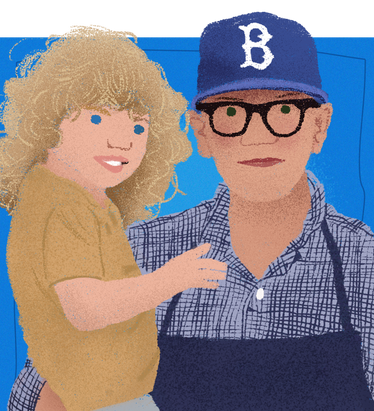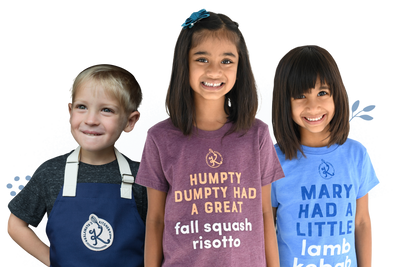
Taste Bud Profile
Billy Durney

I love thinking about the fact that the smell of a famed BBQ restaurant completely changed the trajectory of Billy Durney's life. When you're lucky enough to hang out with Billy, you see that this makes complete sense. The former personal security to the stars turned BBQ legend and restaurateur is a man of unbridled enthusiasm and passion for the things he loves. Born and raised in Brooklyn, Billy describes his approach to his "style" of BBQ as not trying to imitate any of the other established or recognized styles, but chasing the flavors of the world that he has loved and wants to honor. He has the same all-encompassing, all-are-welcome style whether you are in one of his restaurants or just bump into him on the streets of Brooklyn—and he's teaching that enthusiasm and unwavering sense of hospitality to his son Finn by example every day.



Billy Durney: My fondest food memories from childhood are definitely of my grandmother. She was an amazing woman—she immigrated to Red Hook in the early 30s from Norway. Her father was employed by an Italian family in the area, and she was raised in a very Italian neighborhood. Honestly, my Norwegian grandmother was one of the finest Italian cooks on the planet. Every Sunday we’d head to her house in Staten Island, and the smell of her sauce, which we called Sunday gravy, just blew me away. You’d walk in and the whole place would smell like braciole, and tomatoes, and spicy sausage, and meatballs and fresh bread she’d bake—those memories were my first of being completely transfixed by food. I think it’s amazing that she so completely adopted the culture of the place and people where she moved, but never let go of her Norwegian heritage too. She still spoke Norwegian her whole life, and would make us some Norwegian dishes like thin, crepe-like Norwegian pancakes, but we’d just run for her Italian cooking. It was unbelievable.

The fascination with woodsmoke came from the other side of the family. My grandfather was a real mountain guy. He’d chop down trees to make a fire, and those smells really stuck with me early on. Certainly I couldn’t have known then that it would tie to food later in my life, but that aroma was definitely very intoxicating for me at a young age. I think it was somewhere in my subconscious when I started coming up with ideas around food. I thought about all the different kinds of wood and the characters they have—maple, ash, oak, birch—they all have such distinct smells when they burn. I can make distinctions between them, maybe better than I can do with wine! Some are sweeter smokes, some are more harsh. Some, like mesquite, are very peppery. They all have their own characters and behave their own ways. I guess I’m a bit of a sommelier of woodsmoke.
Smoke is absolutely my favorite ingredient. It’s as important as salt.
It’s a flavor and should be treated as a balanced component like any other ingredient in a dish. You don’t want it to overpower anything, but you want its character to shine. I think that’s what separates great barbecue from the rest— whether smoke overpowers the dish just so people know that you’re smoking things, or whether it’s treated delicately, and intentionally. I like to call it a kiss of smoke. And I think about it from a couple different angles, like the fact that when you’re actually eating in the restaurant, you’re definitely enveloped by the smell, but when you take a bite, it’s just that kiss. You still get to taste every part of the dish. It’s a balance of senses and flavors.
I spent years traveling around the world as private security. I remember being really struck by watching people, particularly in Latin America, cook meat over open flame. That was such a spark of fascination, and inspiration. I needed to learn more about that. A few months after I realized how much that interested me, I walked into Louie Mueller Barbecue in Taylor Texas, which completely changed my life. I came home and decided that that’s what I wanted to do with my life, but I knew I had to dive deeper and learn more before I could really do my own thing. So I travelled the country and the world, eating all these different kinds of food. And I came home, and I suddenly felt disappointed—I had eaten so many things I loved, and I wanted to do barbecue, but I didn’t want to re-create whole-hog from North Carolina, though I loved it. I didn’t want a mashup of pulled pork from over here, ribs from St Louis, brisket from Texas, though I loved all of that too. I just didn’t know if I had a place in this world of barbecue because I didn’t want to copy anybody. One night I was out to dinner and the answer hit me like a ton of bricks. I grew up in the most diverse place on earth. In my hometown were people and restaurants who made the most incredible food. I started to remember the Korean grocery owned by my friend’s parents, and the Chinese restaurant that is still there today, and the basketball court where I’d play ball near my neighborhood. I had such strong relationships with all of these different people and foods, and I realized that I could use those memories to pay homage to my own experiences as a child. I’m not making “authentic” Korean food when I make Korean sticky ribs—I’m remembering how I felt and what those smells and flavors were when I’d walk into the back of the store where my friends were doing their homework and eating something their mom made. Or what it was like to eat Chinese spare ribs and rice on the curb with my buddies. Or what it was like to take the bus down Flatbush Avenue, passing all the West Indian and Caribbean neighborhoods to get to the train to Manhattan. I’m getting the goosies just thinking about it! The windows on the bus slid open, and I’d have my head hanging out just drinking it all in. And there were these ladies with shopping carts that they transformed into grills making jerk chicken all up and down Flatbush Ave. The waft of the jerk scent just smashed me in the face. I thought it was ingenious. I loved it. I didn’t realize it then, but I was surrounded by inspiration. That’s how Hometown became what it is. I grew up going to the 18th ave feast and the St Gennaro feast. The best bite you could get would be a sausage and peppers sandwich with provolone. I always loved it. So when we opened Hometown, I had a jalapeño and cheddar sausage on the menu. It was delicious, but it didn’t quite feel like me. So I remembered how I felt about that sandwich, and I re-created it: I put every single ingredient from that sandwich inside a sausage, including the bread. It’s my tribute to those festivals I looked forward to every year as a kid. My two favorite restaurants are Peter Luger and Katz deli— so I made pastrami, one of my favorite foods in the world, into fat slabs of bacon, as an ode to both places. All these dishes, from the Lower East Side to Vietnam to China to the West Indies, all of the cultures represented on my menu—it’s a complete tribute to growing up in Brooklyn and all of my beautiful friends.
I’ve learned throughout my life to embrace food with reckless abandon. To not be afraid of it, and to try everything at least once.
There are perhaps some things I might react too quickly and say ‘oh I don’t like that’—but it’s not even true. Because actually I know that if I ate it with someone who really understood it, and they could walk me through it, tell me something about it, and make me see what’s special about it to them, I’d have total respect and appreciation for it—and probably really love it. So definitely keep an open mind. The most important thing to remember, I think, is that food is never just food. There’s always a story behind it. Whether it’s a generational recipe handed down from great great grandparents, or street food you’re trying somewhere in the world, there’s a massive amount of history behind it. That food came from somewhere. I think for children, teaching them to be interested in the story is key. Say you’re eating pastrami, for example. There’s a conversation to be had about the migration of people, about curing and preservation, and also of course why it tastes so good. Peking duck is another great example—do you know how much time and technique it takes to make it? And how long that dish has been around? There’s such an incredible history behind any one dish you might try. It’s frankly incredible that it ended up in front of you. That’s how I feel. What I love about food and history is that it originates somewhere, maybe out of necessity, maybe out of celebration, maybe both, and then it’s influenced throughout years and years by changes in agriculture, trade, population demographics and immigration—it’s amazing. Think about it not like you’re just eating chicken curry, but you’re eating the traditions, the emotion, and the years of history behind that bite. It touches so many other aspects of culture, and reminds us that we’re all connected. That’s something that can get lost, I think, when we put walls up. But food proves that we’re all the same, and that we’re all connected. I’ll never tire of learning about how one bite can represent so many people, places, cultures, and histories. There are so many opportunities to learn, and as I get older and more introspective and sentimental, I’m just more ready than ever to soak it all up and share and learn from the experiences of my friends and family.


